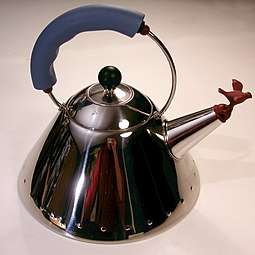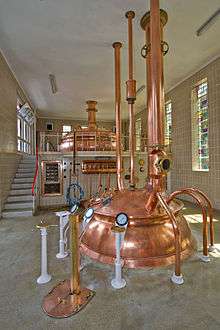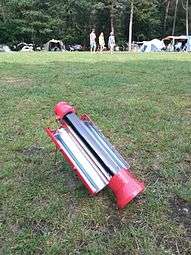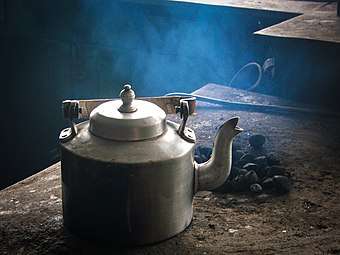Kettle
A kettle, sometimes called a tea kettle or teakettle, is a type of pot, specialized for boiling water, with a lid, spout, and handle, or a small kitchen appliance of similar shape that functions in a self-contained manner. Kettles can be heated either by placing on a stove, or by their own internal electric heating element in the appliance versions.


Etymology


The word kettle originates from Old Norse ketill "cauldron". The Old English spelling was cetel with initial che- [tʃ] like 'cherry', Middle English (and dialectal) was chetel, both come (together with German Kessel "cauldron") ultimately from Germanic *katilaz, that was borrowed from Latin catillus, diminutive form of catinus "deep vessel for serving or cooking food",[1] which in various contexts is translated as "bowl", "deep dish", or "funnel".
Stovetop kettles
A modern stovetop kettle is a metal vessel, with a flat bottom, used to heat water on a stovetop or hob.[2] They usually have a handle on top, a spout, and a lid. Some also have a steam whistle that indicates when the water has reached boiling point.
Kettles are typically made with stainless steel, but can also be made from copper or other metals.
Electric kettles
In countries with 200-240 V mains electricity, electric kettles are commonly used to boil water without the necessity of a stove top. The heating element is typically fully enclosed, with a power rating of 2–3 kW. This means that the current draw for an electric kettle is upwards of 10 A, which is a sizeable proportion of the current available for a typical home: the main fuse of most homes varies between 20 and 100 Amps. For this reason electric kettles, while available, are less popular in countries with 110 V mains electricity, where electric sockets are often current limited to providing around 1.5 kW.[3][4][5]
In modern designs, once the water has reached boiling point, the kettle automatically deactivates, preventing the water from boiling away and damaging the heating element.[6][7][8] A more upright design, the "jug"-style electrical kettle, can be more economical to use, since even one cup of water will keep the element covered.
In the United States, an electric kettle may sometimes be referred to as a hot pot.
Development
Electric kettles were introduced as an alternative to stove top kettles in the latter part of the 19th century. In 1893 the Crompton and Co. firm in the United Kingdom started featuring electric kettles in their catalogue. However, these first electric kettles were quite primitive as the heating element couldn't be immersed in the water. Instead, a separate compartment underneath the water storage area in the kettle was used to house the electric heating element. The design was inefficient even relative to the conventional stove-top kettles of the time.
In 1922, the problem was finally solved by Leslie Large, an engineer working at Bulpitt & Sons of Birmingham who designed an element of wire wound around a core and sheathed in a metal tube. As this element could be immersed directly into the water it made the new electric kettle much more efficient than stovetop kettles.[9][10]
In 1955, the newly founded British company Russell Hobbs brought out its stainless steel K1 model as the first fully automatic kettle.[11] A thermostat, triggered by the rising steam as the water would come to boil, would flex, thereby cutting off the current.[8][7]
Automatic kettles
These are relatively new kinds of tea kettle. They are high tech kitchen appliances that are geared towards making tea brewing easy for everyone. They are built with the capability to intelligently make different kinds of tea without much input from the user.
Once set, the automatic kettle brings the water to the specific temperature for preparing a given kind of tea, adds the tea to the water, and steeps the tea for the appropriate amount of time. Often they will make beeping sound to alert the user when the tea is ready, and maintain the temperature of the beverage after preparation.[12]
Kettle gallery

 Aluminium çaydanlık. A unique instrument of Turkish cuisine.
Aluminium çaydanlık. A unique instrument of Turkish cuisine.- Kettle on a portable stove at the Museu da Baronesa, Brazil

 Graves kettle, 1984, a post-modern kettle with a bird-shaped whistle on the spout
Graves kettle, 1984, a post-modern kettle with a bird-shaped whistle on the spout- A contemporary "jug"‑style electric kettle made from enameled metal and plastic
 Industrial-scale copper kettles used in a beer brewery
Industrial-scale copper kettles used in a beer brewery Solar powered kettle
Solar powered kettle A Kelly kettle, designed to efficiently use the heat of a small fire in a chamber at the base
A Kelly kettle, designed to efficiently use the heat of a small fire in a chamber at the base Copper coated Cast Iron Stove Tea Kettle made between 1846-1860. Albany/Troy NY, USA
Copper coated Cast Iron Stove Tea Kettle made between 1846-1860. Albany/Troy NY, USA An Indian aluminium kettle, popular in South Asia, used for making tea or boiling water
An Indian aluminium kettle, popular in South Asia, used for making tea or boiling water
Similar devices
- A cauldron is a large kettle hung over an open fire, usually on an arc-shaped hanger called a bail.
- A fish kettle is a long slim metal cooking vessel with a tight fitting lid to enable cooking of whole large fish such as salmon.
- A kettle grill is a dome shaped grill with a rounded lid, resembling a cauldron.
- A kettle drum is a kettle (cauldron) shaped drum.
See also
- Boiling vessel, water heating system in British tanks
- Kelly Kettle, specialized types of kettles for outdoor use, intended to use fuel more efficiently
- Samovar, a kettle with central firepit and chimney for making tea and serving it hot in Russia, Iran, Turkey and around
- Tea culture
- Teapot, a vessel with spout, lid, and handle, for brewing and serving tea
- Teasmade, an English appliance that combined a kettle and a teapot to make tea automatically by a clock
- Tetsubin, a cast iron Japanese pot with a spout
- Windermere kettle
References
- T. F. Hoad, English Etymology, Oxford University Press, 1993 (ISBN 0-19-283098-8). p. 252.
- "Electric Tea Kettle". MadeHow.com. Retrieved 30 July 2012.
- Spector, Dina (24 December 2015). "Why Europeans use electric kettles but Americans don't". Business Insider. Retrieved 20 September 2017.
- Stevenson, Seth. "A Watched Pot". Slate. Retrieved 20 September 2017.
- Didovich, Natalia (10 March 2017). "The common Kiwi kitchen essential Americans don't use". Stuff. Retrieved 20 September 2017.
- How Does The Switching System Turn Off An Electric Kettle When It Boils?, Blurtit.com. Retrieved 3 April 2013.
- "Electric Kettles" (PDF). Museum of Science and Industry. Archived from the original (PDF) on 2014-04-01.
- "Made in the UK: The life-changing everyday innovations which put British genius on the map".
- "Electric Kettles". The Memory Store. John Lewis Partnership. Archived from the original on 2013-10-02. Retrieved 2013-06-24.
- "Small Appliances". The Association of Manufacturers of Domestic Appliances. Retrieved 2013-06-24.
- Watson-Smyth, Kate (8 July 2010). "The Secret History Of: The Russell Hobbs K2 kettle". The Independent. Retrieved 20 September 2017.
- "Tea Kettle".
Further reading
| Wikimedia Commons has media related to Kettles. |
- Stevenson, Seth (Nov. 8, 2005). "A Watched Pot". Slate.
- Copeland, Paul L. (2000). Engineering Studies: The Definitive Guide. Allawah, New South Wales: Anno Domini. ISBN 9780646394596.